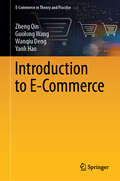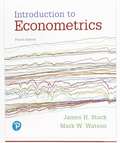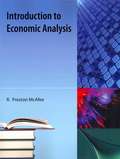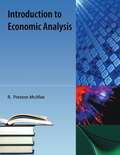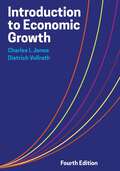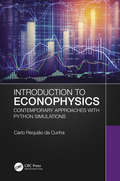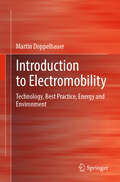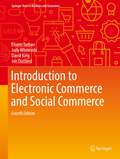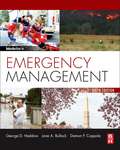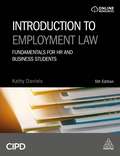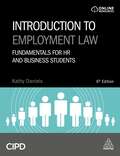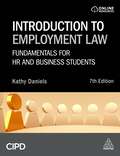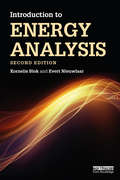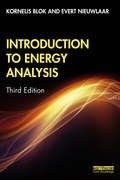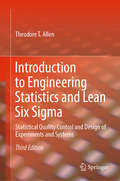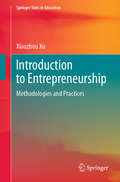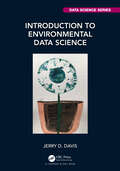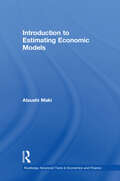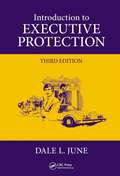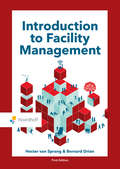- Table View
- List View
Introduction to E-Commerce (E-Commerce in Theory and Practice)
by Zheng Qin Guolong Wang Wanqiu Deng Yanli HaoThis book brings together the new trends, new knowledge, new methods and new tools in the development of e-commerce in China and global and appropriately expounds the basic concepts and cultural concepts of e-commerce from the perspective of e-commerce basic knowledge and e-commerce culture. The key technology involved including e-commerce support, payment, and security is introduced. This book highlights the practical application of the applied psychology of e-commerce in business activities and expounds the system structure, transaction mode, and decision-making strategy paradigm of e-commerce with typical examples. This book helps readers to understand the basic concepts, the latest knowledge and the way of e-commerce development. This book elaborates the theory, specific tools, methods, and practical experience, which can be used as a textbook or professional book for e-commerce courses and also a reference book for interested readers.
Introduction to Econometrics
by Mark Watson James StockEnsure students grasp the relevance of econometrics with Introduction to Econometrics -- the text that connects modern theory and practice with motivating, engaging applications. The 4th Edition maintains a focus on currency, while building on the philosophy that applications should drive the theory, not the other way around. The text incorporates real-world questions and data, and methods that are immediately relevant to the applications. With very large data sets increasingly being used in economics and related fields, a new chapter dedicated to Big Data helps students learn about this growing and exciting area. This coverage and approach make the subject come alive for students and helps them to become sophisticated consumers of econometrics.
Introduction to Econometrics: Principles and Applications (3rd Edition)
by Wallace E. Oates Harry H. KelejianIntroduction To Econometrics: Principles And Applications
Introduction to Economic Analysis
by R. Preston McafeeThis book presents introductory economics ("principles") material using standard mathematical tools, including calculus. It is designed for a relatively sophisticated undergraduate who has not taken a basic university course in economics. It also contains the standard intermediate microeconomics material and some material that ought to be standard but is not. The book can easily serve as an intermediate microeconomics text. The focus of this book is on the conceptual tools and not on fluff. Most microeconomics texts are mostly fluff and the fluff market is exceedingly over-served by $100+ texts. In contrast, this book reflects the approach actually adopted by the majority of economists for understanding economic activity. There are lots of models and equations and no pictures of economists.
Introduction to Economic Analysis
by R. Preston McafeeThis book presents introductory economics ("principles") material using standard mathematical tools, including calculus. It is designed for a relatively sophisticated undergraduate who has not taken a basic university course in economics. It also contains the standard intermediate microeconomics material and some material that ought to be standard but is not. The book can easily serve as an intermediate microeconomics text. The focus of this book is on the conceptual tools and not on fluff. Most microeconomics texts are mostly fluff and the fluff market is exceedingly over-served by $100+ texts. In contrast, this book reflects the approach actually adopted by the majority of economists for understanding economic activity. There are lots of models and equations and no pictures of economists. Bookshare demo title.
Introduction to Economic Analysis
by R. Preston Mcafee Tracy R. LewisThis book presents standard intermediate microeconomics material and some material that, in the authors' view, ought to be standard but is not. Introductory economics material is integrated. Standard mathematical tools, including calculus, are used throughout. The book easily serves as an intermediate microeconomics text, and can be used for a relatively sophisticated undergraduate who has not taken a basic university course in economics. The focus of this book is on the conceptual tools and not on fluff. As such, it reflects the approach actually adopted by the majority of economists for understanding economic activity. There are lots of models and equations, and no pictures of economists ;-) Economic analysis is used in many situations. When British Petroleum sets the price for Alaskan crude oil, it uses an estimated demand model, both for gasoline consumers and also for the refineries to which BP sells. Economic analysis was used by experts in the antitrust suit brought by the U.S. Department of Justice both to understand Microsoft s incentive to foreclose (eliminate from the market) rival Netscape and consumer behavior in the face of alleged foreclosure. Stock market analysts use economic models to forecast the profits of companies to predict the price of their stocks. When the government forecasts the budget deficit or considers a change in environmental regulations, it uses economic models. This book presents the building blocks of the models in common use by an army of economists thousands of times per day. This book, plus econometrics, provides most of the economic analysis tools to take upper division economics courses of any type.
Introduction to Economic Analysis
by R. Preston Mcafee Tracy R. LewisThis book presents standard intermediate microeconomics material and some material that, in the authors' view, ought to be standard but is not. Introductory economics material is integrated. Standard mathematical tools, including calculus, are used throughout. The book easily serves as an intermediate microeconomics text, and can be used for a relatively sophisticated undergraduate who has not taken a basic university course in economics. The focus of this book is on the conceptual tools and not on fluff. As such, it reflects the approach actually adopted by the majority of economists for understanding economic activity. There are lots of models and equations, and no pictures of economists ;-) Economic analysis is used in many situations. When British Petroleum sets the price for Alaskan crude oil, it uses an estimated demand model, both for gasoline consumers and also for the refineries to which BP sells. Economic analysis was used by experts in the antitrust suit brought by the U.S. Department of Justice both to understand Microsoft s incentive to foreclose (eliminate from the market) rival Netscape and consumer behavior in the face of alleged foreclosure. Stock market analysts use economic models to forecast the profits of companies to predict the price of their stocks. When the government forecasts the budget deficit or considers a change in environmental regulations, it uses economic models. This book presents the building blocks of the models in common use by an army of economists thousands of times per day. This book, plus econometrics, provides most of the economic analysis tools to take upper division economics courses of any type.
Introduction to Economic Growth (Fourth Edition)
by Dietrich Vollrath Charles I. JonesA revision worth waiting for Introduction to Economic Growth, Fourth Edition is the only text to synthesize the research and thinking on growth in a way that is accessible to undergraduates. Highlights of this thorough revision are its emphasis and discussion of recent advancements in how we understand our economy of ideas and updates to show how core models—Romer, Solow, and Schumpeter— impact decision making. This purchase offers access to the digital ebook only.
Introduction to Economics (Routledge Revivals)
by John Roscoe TurnerOriginally published in 1919, this book is an outgrowth of classroom discussions. It contains in substance the talks on economics which have been made, for the past eleven years, to the author's classes in Cornell and New York Universities. The time has long since passed when a single volume can treat exhaustively the whole field of economics; designed as an introduction, this book will servce as a means to the end of a more intelligent study of economic questions and prepares the mind of the student for the thought contained in the more advanced and specialized works on the subject and the practical applications they reveal.
Introduction to Econophysics: Contemporary Approaches with Python Simulations
by Carlo Requião da CunhaEconophysics explores the parallels between physics and economics and is an exciting topic that is attracting increasing attention. However there is a lack of literature that explains the topic from a broad perspective. This book introduces advanced undergraduates and graduate students in physics and engineering to the topic from this outlook, and is accompanied by rigorous mathematics which ensures that this will also be a good guide for established researchers in the field as well as researchers from other fields, such as mathematics and statistics, who are interested in the topic. Key features: Presents a multidisciplinary approach that will be of interest to students and researchers from physics, engineering, mathematics, statistics, and other physical sciences Accompanied by Python code with further learning opportunities, available for readers to download from the CRC Press website. Accessible to both students and researchers Carlo R. da Cunha is an associate professor of physics and engineering physics at the Universidade Federal do Rio Grande do Sul (Brazil) and has been since 2011. Dr. da Cunha received his M.Sc. Degree from the West Virginia University in 2001 and his Ph.D. degree from Arizona State University in 2005. He was a postdoctoral researcher at McGill University in Canada in 2006 and an assistant professor of engineering at the University Federal de Santa Catarina between 2007 and 2011. He has been a guest professor at the Technische Universität Wien (Austria), Chiba University (Japan) and Arizona State University (US). His research revolves around the physics of complex systems where he has been drawing parallels between physical and economic systems from quantum to social levels.
Introduction to Electromobility: Technology, Best Practice, Energy and Environment
by Martin DoppelbauerThe book provides a comprehensive overview of all relevant technical and environmental aspects relating to road vehicles with low-emission drive technology. The focus is on electric and hybrid vehicles, whose drive technology, energy storage (batteries, hydrogen) and charging systems are presented in detail. It also deals with overarching framework conditions such as climate protection, generation and distribution of electrical energy and hydrogen, raw materials, life cycle assessment and costs. The latest technical developments have been taken into account in this updated edition. The facts are made clear in many breakdown graphics. Examples deepen the material or provide a practical reference so that the content is more memorable for students. This book is aimed, among others, at students from the subjects of automotive technology, energy technology, electrical engineering, energy supply, energy economics, mechanical engineering and industrial engineering.
Introduction to Electronic Commerce and Social Commerce (Springer Texts in Business and Economics)
by David King Efraim Turban Judy Whiteside Jon OutlandThis is a complete update of the best-selling undergraduate textbook on Electronic Commerce (EC). New to this 4th Edition is the addition of material on Social Commerce (two chapters); a new tutorial on the major EC support technologies, including cloud computing, RFID, and EDI; ten new learning outcomes; and video exercises added to most chapters. Wherever appropriate, material on Social Commerce has been added to existing chapters. Supplementary material includes an Instructor’s Manual; Test Bank questions for each chapter; Powerpoint Lecture Notes; and a Companion Website that includes EC support technologies as well as online files.The book is organized into 12 chapters grouped into 6 parts. Part 1 is an Introduction to E-Commerce and E-Marketplaces. Part 2 focuses on EC Applications, while Part 3 looks at Emerging EC Platforms, with two new chapters on Social Commerce and Enterprise Social Networks. Part 4 examines EC Support Services, and Part 5 looks at E-Commerce Strategy and Implementation. Part 6 is a collection of online tutorials on Launching Online Businesses and EC Projects, with tutorials focusing on e-CRM; EC Technology; Business Intelligence, including Data-, Text-, and Web Mining; E-Collaboration; and Competition in Cyberspace.
Introduction to Emergency Management (6th Edition)
by Damon P. Coppola Jane A. Bullock George D. HaddowIntroduction to Emergency Management sets the standard for excellence in the field and has educated a generation of emergency managers. Haddow, Bullock, and Coppola return for the sixth edition with an emphasis on climate change as a major hazard. Fully updated throughout for new regulations and workflows, with new case studies covering the latest in best practices, this classic textbook prepares students for the challenges of a career in emergency management. Expanded information on disaster recovery coordination structures; Emphasis on climate change as a key hazard faced by disaster managers; Coverage of social media as critical tool in emergency management; Fully updated throughout for the latest regulations and workflows; New examples and case studies throughout; Updated ancillaries to keep course instruction fresh.
Introduction to Employment Law: Fundamentals for HR and Business Students
by Kathy DanielsWritten specifically for HR and Business students, Introduction to Employment Law is a clear and accessible guide to employment law and how it applies in practice. Covering everything from employment tribunals and discrimination to redundancy and termination of employment, this textbook doesn't assume any prior knowledge of the UK legal system and equips students with all the knowledge and skills that they need to take forward into the workplace.Fully revised with all the latest cases and legal developments, this new edition includes coverage of hot topics such as defining employment status in the gig economy, gender pay reporting, the General Data Protection Regulation (GDPR) and the legal implications to be considered with Britain's withdrawal from the European Union. Packed with pedagogical features to consolidate learning including chapter objectives, tasks, 'explore further' sections, key learning points and examples to work through, as well as a dedicated study skills chapter, Introduction to Employment Law is essential reading for all students studying the CIPD Level 5 Intermediate module in employment law as well as being a useful resource for those studying at level 3 and an accessible introduction for level 7 and those on undergraduate and postgraduate courses needing a thorough grounding in employment law. Online resources include lecture slides, case studies, multiple choice questions, annotated weblinks and an instructor's manual.
Introduction to Employment Law: Fundamentals for HR and Business Students
by Kathy DanielsWritten specifically for HR and business students, Introduction to Employment Law is a clear, accessible and jargon-free guide to UK employment law and how it applies in practice. This book covers all the essentials of employment law including employment contracts, discrimination, redundancy and employment tribunals. There is also expert guidance on key issues including shared parental leave, flexible working policies and protected characteristics. Fully revised with the latest cases and legal developments, this new edition includes coverage of the rights of agency workers, bereavement leave, furlough practices and the legal implications of Brexit. This textbook doesn't assume any prior knowledge of the UK legal system and equips students with the knowledge and skills that they need to take forward into the workplace. Packed with pedagogical features to consolidate learning including tasks, examples, explore further sections and key learning points as well as a dedicated study skills chapter covering employment law assignments and exams, Introduction to Employment Law is essential reading for all students studying the CIPD Level 5 Intermediate module in employment law. It is also an accessible introduction for Level 7 students and those on undergraduate and postgraduate business courses needing a thorough grounding in employment law. Online resources include lecture slides, case studies, annotated weblinks and an instructor's manual.
Introduction to Employment Law: Fundamentals for HR and Business Students
by Kathy DanielsIntroduction to Employment Law is a clear, accessible and jargon-free guide to UK employment law and its application in the workplace. Written specifically for HR and business students, this book provides a thorough grounding in the essentials of employment law. All areas of employment law are addressed, including employment contracts, discrimination, redundancy and the legal duties of both the employer and the employee. This new edition has been updated throughout to cover the latest case law and legal developments including changes to annual leave, areas of family leave including Carer's Leave and developments in discrimination legislation. Assuming no prior knowledge of the UK legal system, this is ideal reading for all those studying the specialist employment law module on the CIPD Associate Diploma. It is also an accessible introduction for Advanced Diploma students and those on general business degrees who need an introduction to UK employment law. This book is packed with pedagogical features to help consolidate learning including tasks, examples, explore further sections, key learning points and a dedicated study skills chapter. Online resources include lecture slides, case studies, weblinks, multiple choice questions and an instructor's manual.
Introduction to Energy Analysis
by Kornelis Blok Evert NieuwlaarThe energy supply and demand system is of great importance for society, from economic, social, and ecological viewpoints. The last decade in particular has seen rapid changes in the world of energy systems, and it is therefore now an important area for study, academic research, and professional work. This textbook provides an introduction to energy analysis for those students who want to specialise in this challenging field. In comparison to other textbooks, this book provides a balanced treatment of complete energy systems, covering the demand side, the supply side, and the energy markets that connect these. The emphasis is very much on presenting a range of tools and methodologies that will help students find their way in analysing real world problems in energy systems. Featuring learning objectives, further readings and practical exercises in each chapter, An Introduction to Energy Analysis will be essential reading for upper-level undergraduate and postgraduate students with a background in the natural sciences and egineering. This book may also be useful for professionals dealing with energy issues, as a first introduction into the field.
Introduction to Energy Analysis
by Kornelis Blok Evert NieuwlaarThis textbook provides an introduction to energy analysis for those students who want to specialise in this challenging field. In comparison to other textbooks, this book provides a balanced treatment of complete energy systems, covering the demand side, the supply side, and the energy markets that connect these. The emphasis is very much on presenting a range of tools and methodologies that will help students find their way in analysing real world problems in energy systems. This new edition has been updated throughout and contains additional content on energy transitions and improvements in the treatment of several energy systems analysis approaches. Featuring learning objectives, further readings and practical exercises in each chapter, Introduction to Energy Analysis will be essential reading for upper-level undergraduate and postgraduate students with a background in the natural sciences and engineering. This book may also be useful for professionals dealing with energy issues, as a first introduction into the field.
Introduction to Engineering Statistics and Lean Six Sigma: Statistical Quality Control and Design of Experiments and Systems
by Theodore T. AllenThis book provides an accessible one-volume introduction to Lean Six Sigma and statistics in engineering for students and industry practitioners. Lean production has long been regarded as critical to business success in many industries. Over the last ten years, instruction in Six Sigma has been linked more and more with learning about the elements of lean production. Building on the success of the first and second editions, this book expands substantially on major topics of increasing relevance to organizations interested in Lean Six Sigma. Each chapter includes summaries and review examples plus problems with their solutions. As well as providing detailed definitions and case studies of all Six Sigma methods, the book uniquely describes the relationship between operations research techniques and Lean Six Sigma. Further, this new edition features more introductory material on probability and inference and information about Deming's philosophy, human factors engineering, and the motivating potential score – the material is tied more directly to the Certified Quality Engineer (CQE) exam. New sections that explore motivation and change management, which are critical subjects for achieving valuable results have also been added. The book examines in detail Design For Six Sigma (DFSS), which is critical for many organizations seeking to deliver desirable products. It covers reliability, maintenance, and product safety, to fully span the CQE body of knowledge. It also incorporates recently emerging formulations of DFSS from industry leaders and offers more introductory material on experiment design, and includes practical experiments that will help improve students’ intuition and retention. The emphasis on lean production, combined with recent methods relating to DFSS, makes this book a practical, up-to-date resource for advanced students, educators and practitioners.
Introduction to Entrepreneurship: Methodologies and Practices (Springer Texts in Education)
by Xiaozhou XuThis textbook helps readers increase their entrepreneurial knowledge, improve their competences, and expand their entrepreneurial thinking.The book consists of nine chapters: Expand Entrepreneurial Vision, Improve Entrepreneurial Quality, Prepare for Entrepreneurship Education, Identify Entrepreneurial Opportunities, Build An Entrepreneurship Team, Compose the Business Plan, Planing Entrepreneurial Strategy, Avoid Entrepreneurial Risks, and Optimize Entrepreneurial resources. It allows readers new to the area to gain an understanding of entrepreneurship and provides a solid basis for starting a business in the future. Each chapter includes learning objectives and “leads” at the beginning and ends with review and “think and discuss” sections.
Introduction to Environmental Data Science (Chapman & Hall/CRC Data Science Series)
by Jerry DavisIntroduction to Environmental Data Science focuses on data science methods in the R language applied to environmental research, with sections on exploratory data analysis in R including data abstraction, transformation, and visualization; spatial data analysis in vector and raster models; statistics and modelling ranging from exploratory to modelling, considering confirmatory statistics and extending to machine learning models; time series analysis, focusing especially on carbon and micrometeorological flux; and communication. Introduction to Environmental Data Science is an ideal textbook to teach undergraduate to graduate level students in environmental science, environmental studies, geography, earth science, and biology, but can also serve as a reference for environmental professionals working in consulting, NGOs, and government agencies at the local, state, federal, and international levels. Features • Gives thorough consideration of the needs for environmental research in both spatial and temporal domains. • Features examples of applications involving field-collected data ranging from individual observations to data logging. • Includes examples also of applications involving government and NGO sources, ranging from satellite imagery to environmental data collected by regulators such as EPA. • Contains class-tested exercises in all chapters other than case studies. Solutions manual available for instructors. • All examples and exercises make use of a GitHub package for functions and especially data.
Introduction to Environmental Economics and Policy in Japan
by Toshi H. Arimura Akira HibikiThis textbook demonstrates how economic theories can be used for environmental policy evaluations. A notable feature of this book is that, unlike most textbooks in environmental economics written in English, it draws on examples from Japan’s policy on energy, resource, pollution, and carbon emissions. Policy measures discussed in this book include controls on motor vehicle emissions, pricing of waste disposal, deposit-refund scheme for recycling, carbon taxes and emissions trading schemes. With topics involving transboundary environmental concerns such as climate change, air pollution, and waste management and recycling, the book also integrates international perspectives and provides comparisons of policies across regions and countries. A major objective of this book is to present a concise and accessible introduction to environmental economics as applied to policy evaluations in and beyond Japan. The knowledge available from this book must be very useful for students, policymakers and practitioners who seek environmental policy solutions from an economic point of view. This is an open access book.
Introduction to Estimating Economic Models (Routledge Advanced Texts in Economics and Finance)
by Atsushi MakiThe book's comprehensive coverage on the application of econometric methods to empirical analysis of economic issues is impressive. It uncovers the missing link between textbooks on economic theory and econometrics and highlights the powerful connection between economic theory and empirical analysis perfectly through examples on rigorous experimental design. The use of data sets for estimation derived with the Monte Carlo method helps facilitate the understanding of the role of hypothesis testing applied to economic models. Topics covered in the book are: consumer behavior, producer behavior, market equilibrium, macroeconomic models, qualitative-response models, panel data analysis and time-series analysis. Key econometric models are introduced, specified, estimated and evaluated. The treatment on methods of estimation in econometrics and the discipline of hypothesis testing makes it a must-have for graduate students of economics and econometrics and aids their understanding on how to estimate economic models and evaluate the results in terms of policy implications.
Introduction to Executive Protection (Third Edition)
by Dale L. June<p>At a time when personal security risks are on the rise internationally, Introduction to Executive Protection, Third Edition takes readers beyond "the wizard’s curtain" of fear, unawareness, and surprise to give them the tools to sharpen or renew their skills so those they are tasked with protecting remain safe. <p>This third edition of a bestseller goes beyond the basics which were at the heart of the first and second editions. Though it still covers those basics, it goes further by exploring and discussing the lessons learned in the history of assassination―from ancient times to the present. <p>Examining the psychological, philosophical, professional, and training aspects of close personal protection, this edition represents the latest thinking on executive protection in light of increased personal security risks worldwide. It discusses both residential and business security and also covers the first response for natural events such as common medical emergencies.</p>
Introduction to Facility Management (Routledge-Noordhoff International Editions)
by Hester van Sprang Bernard DrionIntroduction to Facility Management is a comprehensive introduction to the dynamic and diverse field of facility management (FM). It answers questions such as: What is facility management? What does a facility management professional do? How can we classify facility management products and services? How do you set up a facility management organisation? How do you manage service processes using a master dashboard? Reflecting on current events, the book defines new and exciting roles for facility management professionals. This first international edition of the bestselling Dutch Basisboek Facility Management describes global trends and developments and international FM-standards and practices. With contributions of thought leaders, such as Diane Levine, Jens Schlüter, Michiel Bakker, Elizabeth Nelson, Nicolas White and Susanne Balslev Nielson, Introduction to Facility Management is the first international book on facility management, which is supplemented and commented on by facility management teachers and practitioners; intriguingly and enthusiastically describes the full scope of the FM-profession; provides a theoretical framework and insight into FM-practice.
